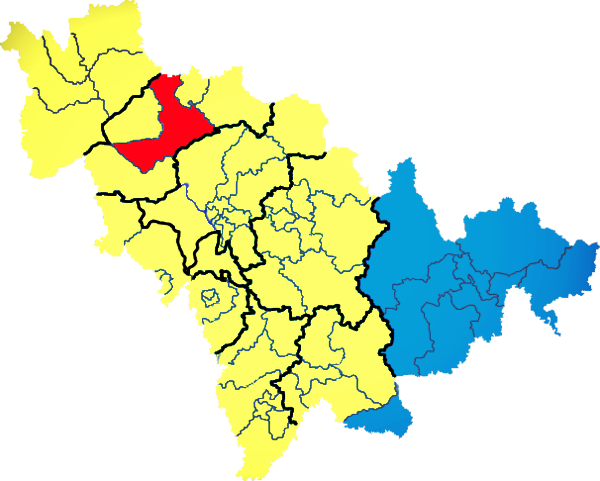|
Chaoyangchuan
Chaoyangchuan is a town in Yanji, Yanbian, Jilin, China. It has a total population of 54,000 and an area of 393 sq km. 65% of the population is Korean Korean may refer to: People and culture * Koreans, people from the Korean peninsula or of Korean descent * Korean culture * Korean language **Korean alphabet, known as Hangul or Korean **Korean dialects **See also: North–South differences in t .... Chaoyangchuan is divided into the following divisions: Shengli Community, Wenhua Community, Chunguang Community, Chaoyang Community, Heping Community, Jicheng Village, Qinlao Village, Taidong Village, Guangshi Village, Dexin Village, Hexing Village, Sanfeng Village, Sancheng Village, Dongfeng Village, Changqing Village, Guangrong Village, Chaoyang Village, Longsheng Village, Liuxin Village, Hengdao Village, Zhongping Village, Taixing Village, Badao Village, Changsheng Village and Hepingdao Village. References Yanji Township-level divisions of Jilin {{Jilin-geo-stub ... [...More Info...] [...Related Items...] OR: [Wikipedia] [Google] [Baidu] |
Yanji
Yanji (; Korean: ; alternately romanized as Yenki or Yenji) is a county-level city in the east of China's Jilin Province, and is the seat of the Yanbian Korean Autonomous Prefecture. Yanji City is located in the eastern part of Jilin Province. It is the seat of the government of Yanbian Korean Autonomous Prefecture and the political, economic and cultural center of the entire autonomous prefecture. Its population is approximately 400,000 of which a significant portion is ethnic Korean. Yanji is a busy hub of transport and trade between China and North Korea. The city is home to Yanbian University, a comprehensive university and the only Project 211 university in Yanji. History Yanji and its environs were largely unpopulated until the 1800s when Qing dynasty rulers of China began to encourage migration there from China proper as part of its '' Chuang Guandong'' policy to populate Manchuria in an effort to stem encroaching Russian expansion. The city was the seat of Jiandao ... [...More Info...] [...Related Items...] OR: [Wikipedia] [Google] [Baidu] |
Jilin
) , image_skyline = Changbaishan Tianchi from western rim.jpg , image_alt = , image_caption = View of Heaven Lake , image_map = Jilin in China (+all claims hatched).svg , mapsize = 275px , map_alt = Map showing the location of Jilin Province , map_caption = Map showing the location of Jilin Province , coordinates = , subdivision_type = Country , subdivision_name = China , named_for = from ''girin ula'', a Manchu language, Manchu phrase meaning "along the river" , seat_type = Capital , seat = , seat1_type = , seat1 = , parts_type = Divisions , parts_style = para , p1 = 9 Prefectures of China, prefectures , p2 = 60 Counties of China, counties , p3 = 1006 Townships of China, townships , government_type = Provinces of China, Province , governing_body = Jilin Provinci ... [...More Info...] [...Related Items...] OR: [Wikipedia] [Google] [Baidu] |
Yanbian
The Yanbian Korean Autonomous Prefecture is an autonomous prefecture in the east of Jilin Province, China. Yanbian is bordered to the north by Heilongjiang Province, to the west by Jilin's Baishan City and Jilin City, to the south by North Korea's North Hamgyong Province, and to the east by Russia's Primorsky Krai. Yanbian is designated as a Korean autonomous prefecture due to the large number of Koreans (Chaoxianzu) living in the region. The prefectural capital is Yanji and the total area is . The prefecture has an important Balhae archaeological sitethe Ancient Tombs at Longtou Mountainwhich includes the Mausoleum of Princess Jeonghyo. History In the Ming dynasty, Yanbian was governed by the Jianzhou Guard () and in the late Qing dynasty the area was divided into the Yanji () and Hunchun () subprefectures. From 1644 to 1800s, the Manchurian Qing state maintained a policy of disallowing Han Chinese immigration into traditionally Manchurian lands in order to ensure that th ... [...More Info...] [...Related Items...] OR: [Wikipedia] [Google] [Baidu] |
China
China, officially the People's Republic of China (PRC), is a country in East Asia. With population of China, a population exceeding 1.4 billion, it is the list of countries by population (United Nations), second-most populous country after India, representing 17.4% of the world population. China spans the equivalent of five time zones and Borders of China, borders fourteen countries by land across an area of nearly , making it the list of countries and dependencies by area, third-largest country by land area. The country is divided into 33 Province-level divisions of China, province-level divisions: 22 provinces of China, provinces, 5 autonomous regions of China, autonomous regions, 4 direct-administered municipalities of China, municipalities, and 2 semi-autonomous special administrative regions. Beijing is the country's capital, while Shanghai is List of cities in China by population, its most populous city by urban area and largest financial center. Considered one of six ... [...More Info...] [...Related Items...] OR: [Wikipedia] [Google] [Baidu] |
Koreans
Koreans are an East Asian ethnic group native to the Korean Peninsula. The majority of Koreans live in the two Korean sovereign states of North and South Korea, which are collectively referred to as Korea. As of 2021, an estimated 7.3 million ethnic Korean diaspora, Koreans resided outside of Korea. Koreans are also an officially recognised ethnic minority in other several Continental and East Asian countries, including Koreans in China, China, Koreans in Japan, Japan, Koryo-saram, Kazakhstan, Koryo-saram, Russia, and Koryo-saram, Uzbekistan. Outside of Continental and East Asia, sizeable Korean communities have formed in Koreans in Germany, Germany, the British Koreans, United Kingdom, Koreans in France, France, the Korean Americans, United States, Korean Canadians, Canada, Korean Australians, Australia, and Korean New Zealanders, New Zealand. Etymology South Koreans refer to themselves as ''Hanguk-in'' or ''Hanguk-saram'', both of which mean "people of the Han". The ... [...More Info...] [...Related Items...] OR: [Wikipedia] [Google] [Baidu] |


